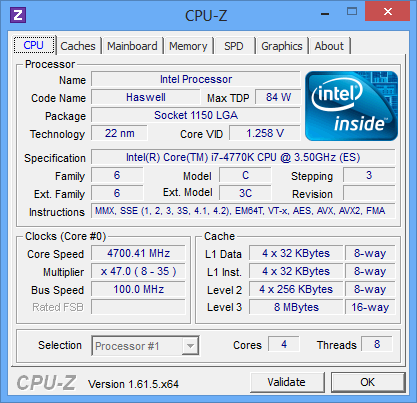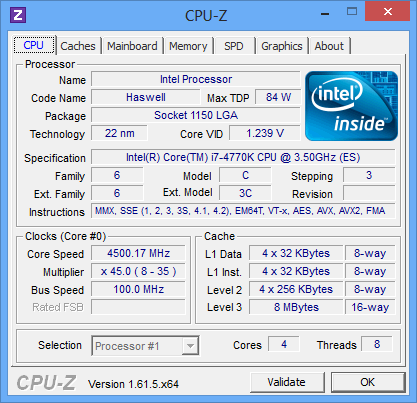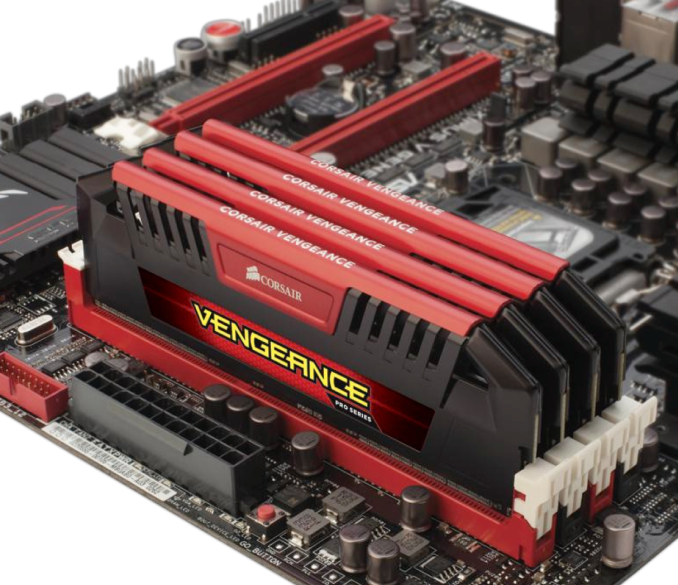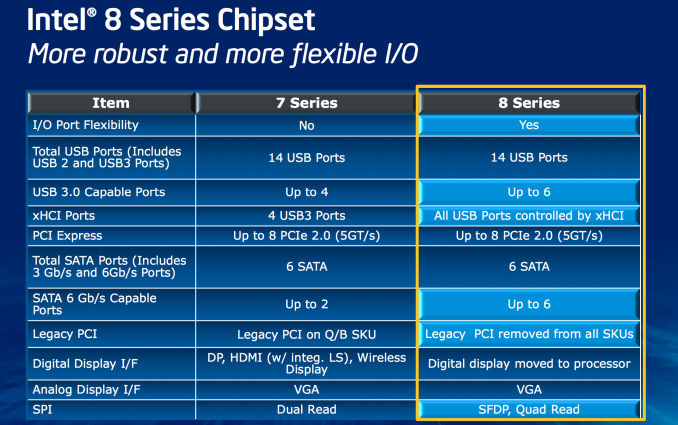The Haswell Review: Intel Core i7-4770K & i5-4670K Tested
by Anand Lal Shimpi on June 1, 2013 10:00 AM ESTMemory
Haswell got an updated memory controller that’s supposed to do a great job of running at very high frequencies. Corsair was kind enough to send over some of its Vengeance Pro memory with factory DDR3-2400 XMP profiles. I have to say, the experience was quite possibly the simplest memory overclocking I’ve ever encountered. Ivy Bridge was pretty decent at higher speeds, but Haswell is a different beast entirely.
Although I used DDR3-2400 for most of my testing, Corsair’s Vengeance Pro line is available in frequencies rated all the way up to 2933MHz.
Platform
Haswell features a new socket (LGA-1150). Fundamental changes to power delivery made it impossible to maintain backwards compatibility with existing LGA-1155 sockets. Alongside the new socket comes Intel’s new 8-series chipsets.
At a high level the 8-series chipsets bring support for up to six SATA 6Gbps and USB 3.0. It’s taken Intel far too long to move beyond two 6Gbps SATA ports, so this is a welcome change. With 8-series Intel also finally got rid of legacy PCI support.
Overclocking
Despite most of the voltage regulation being moved on-package, motherboards still expose all of the same voltage controls that you’re used to from previous platforms. Haswell’s FIVR does increase the thermal footprint of the chip itself, which is why TDPs went up from 77W to 84W at the high-end for LGA-1150 SKUs. Combine higher temperatures under the heatspreader with a more mobile focused chip design, and overclocking is going to depend on yield and luck of the draw more than it has in the past.
Haswell doesn’t change the overclocking limits put in place with Sandy Bridge. All CPUs are frequency locked, however K-series parts ship fully unlocked. A new addition is the ability to adjust BCLK to one of three pre-defined straps (100/125/167MHz). The BCLK adjustment gives you a little more flexibility when overclocking, but you still need a K-SKU to take advantage of the options.


In terms of overclocking success on standard air cooling you should expect anywhere from 4.3GHz - 4.7GHz at somewhere in the 1.2 - 1.35V range. At the higher end of that spectrum you need to be sure to invest in a good cooler as you’re more likely to bump into thermal limits if you’re running on stable settings.

















210 Comments
View All Comments
jmcb - Saturday, June 1, 2013 - link
I currently have an E8400 so the Haswell would be amazing....but I will go for amazing and value._zenith - Saturday, June 1, 2013 - link
"Even on the dekstop" - desktop. Just spelling gripe.I notice the gains over Nehalem are pretty much the same that you can *easily* get (just increase VCore and BCLK) out of overclocking Nehalem. So now they're neck and neck if you don't overclock the Haswell part. Maybe my system will be good for another year now! (i7-920 @ 4.0).
Da W - Saturday, June 1, 2013 - link
YeehaaaNow i can buy my Trinity + Radeon rig for the price of a haswell only rig. I know it will play every videogame made for xbox or PS4 for the next 7-8 years and make a perfect HTPC!
ChefJeff789 - Saturday, June 1, 2013 - link
I've been sitting on a first-gen Core i7 and this is still a little dissapointing. It is significantly quicker than mine, but I'm not sure that the upgrade is quite worth it for me yet as everything I use runs reasonably well. I am interested in the new socket type, though. I wonder if upgrading the motherboard with a decent Haswell would benefit me later on with a Skylake. It's hard to say; I haven't seen any firm specs on the socket-type for the Skylake chips.jwcalla - Saturday, June 1, 2013 - link
At this point I think there are more interesting places to put your tech dollars. A high-DPI display or triple monitors if you're into gaming, more SSDs if you need the space, a NAS or a nice tablet, etc. I'm in your camp with an i7-870 and nothing I do pushes it enough to test my patience.kyuu - Saturday, June 1, 2013 - link
Agreed -- unless you're loaded, there are far more interesting ways to spend your money in the PC arena than on the overhyped and underwhelming Haswell SKUs. Unless you're still stuck on Phenom II or Core2Duo.bji - Sunday, June 2, 2013 - link
Hey - I'm still "stuck" on a Phenom II (in my desktop; laptop is 15 inch rMBP with Ivy Bridge) and it's not that bad. It's significantly slower than the Bridges in single threaded apps but even so it's fast enough that I never notice, much like jwcalla never notices with his i7-870. And the Phenom II x6 has 6 real cores that do decently well in heavily multithreaded apps, really extensive compiles being the only thing that I ever do that would benefit at all from extra speed. 6 real cores holding their own reasonably well there. Even if an Ivy Bridge were 50% faster per core on the compiles (and it probably is), the x6 has 50% more cores so it kind of evens out ...rabbatabba - Sunday, June 2, 2013 - link
Anyone know if x264 is properly optimized for AVX2? Naiively, one might expect a 2x speedup for SIMD integer dominated code over the AVX1-only 2700k provided that the rest of the system is able to shuffle around data.http://com3.tv/wp-content/uploads/2012/09/Haswell-...
I am very curious as to the real-world performance gains of integer (and floating-point FMA) SIMD code in Haswell compared to previous generations.
Klimax - Sunday, June 2, 2013 - link
It has support for AVX2. Not sure in how many places, but over months there was stream of AVX2 code paths.plopingo - Sunday, June 2, 2013 - link
No need for me to upgrade with my I7 960@4.2ghzmaybe next time :D